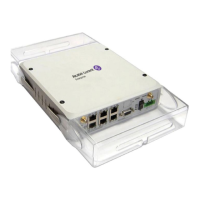Event and Accounting Logs
7705 SAR OS System Management Guide 209
Memory Logs
A memory log is a circular buffer. When the log is full, the oldest entry in the log is replaced
with the new entry. When a memory log is created, the specific number of entries it can hold
can be specified; otherwise, it will assume a default size. An event log can send entries to a
memory log destination.
Log Files
Log files can be used by both event logs and accounting logs and are stored on the compact
flash device (cf3: on all platforms; cf1: or cf2: on the 7705 SAR-18) in the file system.
A log file is identified by a single log file ID, but a log file will generally be composed of a
number of individual files in the file system. A log file is configured with a rollover
parameter, expressed in minutes, which represents the length of time an individual log file
should be written to before a new file is created for the relevant log file ID. The rollover time
is checked only when an update to the log is performed. Thus, this rule is subject to the
incoming rate of the data being logged. For example, if the rate is very low, the actual rollover
time may be longer than the configured value.
The retention time for a log file specifies the amount of time the file should be retained on the
system based on the creation date and time of the file. The retention time is used as a factor
to determine which files should be deleted first if the file system device nears 100% usage.
When a log file is created, only the compact flash device for the log file is specified. Log files
are created in specific subdirectories with standardized names depending on the type of
information stored in the log file.
Event log files are always created in the \log directory on the compact flash device. The
naming convention for event log files is:
logeeff-timestamp
where:
ee is the event log ID
ff is the log file destination ID
timestamp is the timestamp when the file is created in the form of yyyymmdd-hhmmss
where:
• yyyy is the four-digit year (for example, 2008)
• mm is the two-digit number representing the month (for example, 12 for December)
• dd is the two-digit number representing the day of the month (for example, 03 for the
3rd of the month)

